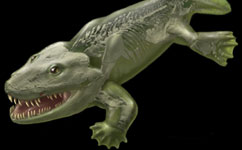Ichthyostega Gets a Re-think Thanks to New Research
New Research Suggests Earlier Reconstructions had the Backbones “Back to Front”
The fossils of the early tetrapod Ichthyostega, the first Devonian tetrapod to be discovered, have always puzzled scientists. This one and a half metres long transitional creature between a fish and a land-dwelling amphibian has always courted controversy and a new study suggests previous attempts to model the vertebrae may have been inaccurate. In effect, the backbone in skeletal reconstructions of this creature may have formerly been “back to front.”
Tetrapods
Tetrapods (the name means “four feet”), are in essence, the limb-bearing vertebrates with four limbs and distinct digits. Human beings (H.sapiens), are members of the tetrapod group. Scientists agree that the tetrapods evolved from fish and the first of these creatures evolved during the Devonian geological period but exactly what group of fishes gave rise to the tetrapods and when remains open to some debate.
Ichthyostega had four limbs, in earlier models this animal was pictured as being well suited to life on land with its robust limbs holding the front portion of the body clear of the ground. It is now thought that the first tetrapods were not so well adapted to a life out of the water and it is likely that if these animals did venture out onto land they would not have been capable of lifting their body weight up, most probably just dragging their bodies along rather than lifting them clear of the land surface.
An Early Interpretation of Ichthyostega
Picture credit: Everything Dinosaur
Professor Jenny Clack (University of Cambridge), a world-authority on early tetrapods in conjunction with her colleague Dr Stephanie Pierce (Royal Veterinary College (London), has published new evidence that provides a fresh insight into the Ichthyostega genus. These distinguished scientists reaffirm that these animals may not have been that well adapted to terrestrial life after all. It is known that Ichthyostega and its near relative Acanthostega had large teeth and that they were predators, what is unclear however, is whether these animals hunted on land or in the water.
The European Synchrotron Radiation Facility in Grenoble (France) was employed by the researchers to bombard three fossil specimens of Ichthyostega with very powerful X-rays. These X-rays once interpreted by sophisticated computer software were able to reveal more details regarding the structure of this tetrapod’s skeleton. The three-dimensional images of the fossil material the research team was able to produce revealed something very surprising. It had been thought that the back bones of early tetrapods were comprised of four separate bones arranged with one at the front, one just behind the first one and a pair towards the rear of each element of the vertebrae. The images, that the team produced showed that in the case of the Ichthyostega fossils, the bones at the back had become fused to the one at the front. This discovery revealed that the first “anterior ” bone at the front of the four bone series was actually the posterior one (at the back). The change in the orientation and the relationship between the bones in the spine would change the way in which this early tetrapod could move
Writing in the academic journal “Nature”, Dr Pierce explained:
“Ichthyostega made us open our minds, stand back and reassess the anatomy of other early tetrapod fossils. When we did this, it was obvious that the bones of their spines were also in the reverse order than what had previously been described.”
Ichthyostega
In addition, the application of new research techniques has enabled the scientists to spot evidence of a primitive sternum in this Devonian animal. The sternum consists of a series of bones that are aligned together and run down the centre of Ichthyostega’s chest. This suggests that the animal’s body weight was supported by the sternum and that the limbs did not hold the body clear of the ground as shown in much earlier illustrations of Ichthyostega, but instead this animal probably moved on land by dragging its body along by moving its front limbs. This method of locomotion is seen today with the Mudskippers (fish from the family Gobiidae). These Gobies are able to haul themselves around on land using their sturdy pectoral fins as simple, efficient forelimbs.
The Latest Interpretation of Ichthyostega
Picture credit: Julia Molner
The research team hope to be able to analyse the vertebrae of other Devonian tetrapods using the European Synchrotron Radiation Facility so that a more detailed understanding of the evolution of terrestrial locomotion can be obtained.
Everything Dinosaur stocks a wide range of models of early tetrapods: Models of Early Tetrapods and Prehistoric Animal Figures.



